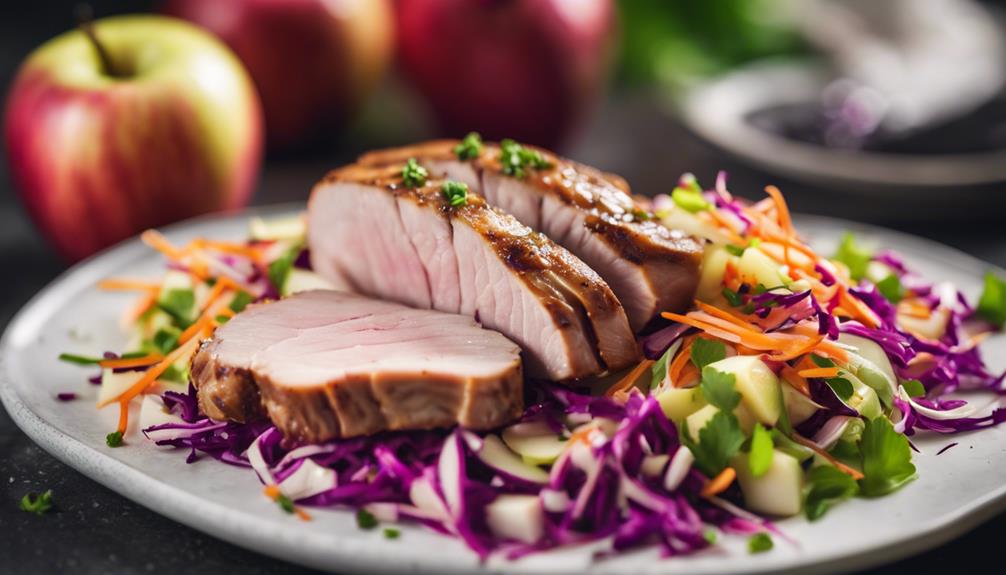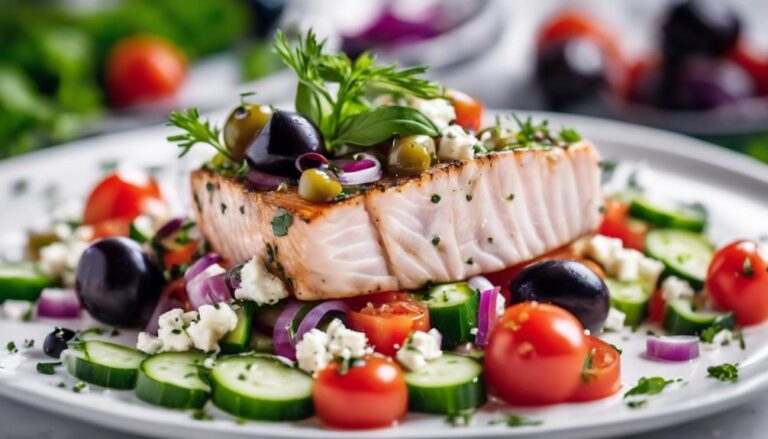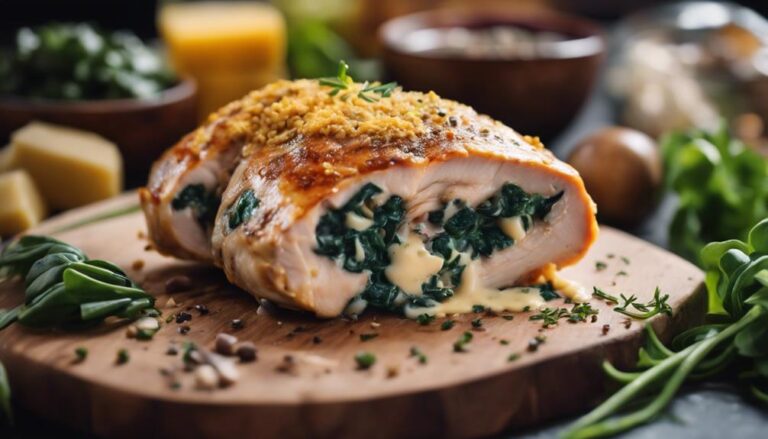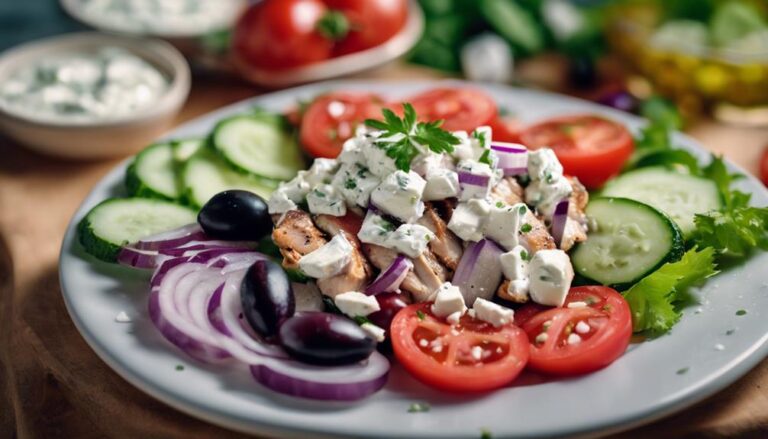Sous Vide Pork Loin With Apple Slaw
For a mouthwatering dish, try sous vide pork loin with apple slaw. Seal the pork in a bag and cook precisely in a water bath for juicy and tender results. This technique, originating in France, guarantees consistent doneness. Use quality ingredients like fresh herbs and spices for enhanced flavors. Searing the pork afterward adds depth and richness to the dish. Consider experimenting with different seasonings for a personalized touch. The apple slaw provides a revitalizing contrast to the savory pork. Elevate your culinary game by exploring the detailed steps and diverse flavors in this delightful recipe.
What You Will Learn Here
- Sous vide pork loin ensures juicy, tender meat.
- Herb crust enhances flavor infusion.
- Searing adds depth and flavor.
- Apple slaw provides a flavorful contrast.
- Experiment with different seasonings and apple types for variety.
Sous Vide Pork Loin Origins

Sous Vide Pork Loin has its origins in the Sous Vide cooking technique, which involves sealing food in airtight bags and cooking it in a water bath at precise temperatures.
The history of Sous Vide dates back to the late 1960s in France, where it was initially used in restaurants to maintain the integrity of delicate foods.
Modern Sous Vide technology has evolved to make this cooking method accessible to home cooks, allowing for precise control over the cooking process.
Sous Vide Pork Technique
Exploring the origins of sous vide pork loin reveals a precise cooking technique that has revolutionized culinary practices. Sous vide benefits lie in its precise cooking, guaranteeing that food is cooked consistently to the desired level of doneness. When it comes to sous vide pork, this technique excels in delivering tender, juicy results. By vacuum-sealing the pork loin and cooking it in a water bath at a controlled temperature, the meat retains its natural juices and flavors, resulting in a succulent and flavorful dish.
The sous vide pork technique involves placing the seasoned pork loin in a plastic bag, removing air to create a vacuum seal, and then submerging it in the precisely heated water. This method allows the pork to cook evenly from edge to edge, ensuring a perfectly cooked piece of meat every time. The slow cooking process ensures that the pork loin is tender and moist, creating a melt-in-your-mouth texture that's hard to achieve with traditional cooking methods.
History of Sous Vide
The origins of sous vide pork loin can be traced back to the late 1960s in France, where chefs and food scientists collaborated to develop this innovative cooking technique. Initially used in commercial kitchens, sous vide has since evolved into a popular method for home cooks seeking precision in their culinary creations.
The evolution of sous vide has been marked by its ability to maintain the natural flavors and juices of ingredients, including pork loin, through precise temperature control and extended cooking times. This method offers several benefits, such as enhancing tenderness, intensifying flavors, and ensuring consistent results with minimal effort.
One of the key advantages of sous vide pork loin is its ability to cook the meat evenly from edge to edge, resulting in a perfectly tender and juicy texture. The controlled cooking environment also helps to retain the natural juices of the pork, creating a flavorful end product that's difficult to achieve through traditional cooking methods.
Modern Sous Vide Technology
As cooking technology advanced, the evolution of sous vide techniques led to the development of modern sous vide technology, revolutionizing the way pork loin and other ingredients are prepared in the culinary world. Sous vide technology advancements have transformed the cooking landscape, allowing for precise temperature control and consistent results. This method involves sealing ingredients in a vacuum-sealed bag and cooking them in a water bath at a precisely regulated temperature for an extended period.
Sous vide cooking methods have gained popularity for their ability to retain the natural flavors and juices of the ingredients, resulting in tender and flavorful dishes. The modern sous vide machines available today make this technique more accessible to home cooks, offering user-friendly interfaces and automated temperature controls. These devices have streamlined the sous vide process, making it easier than ever to achieve restaurant-quality results in your own kitchen.
Embracing modern sous vide technology opens up a world of culinary possibilities, allowing you to explore new flavors and textures with confidence.
Key Ingredients for Flavor
For peak flavor in your sous vide pork loin with apple slaw, prioritize selecting high-quality ingredients such as fresh herbs, aromatic spices, and seasonal produce. To enhance the taste profile of your dish, consider the following key ingredients:
- Fresh Herbs: Incorporating a mix of herbs like rosemary, thyme, or sage can elevate the flavors and add depth to your pork loin.
- Aromatic Spices: Utilize spices such as smoked paprika, cumin, or coriander to infuse your pork loin with rich and complex flavors.
- Seasonal Produce: Opt for fresh, seasonal fruits like apples or pears to create a vibrant and invigorating slaw that complements the savory pork loin perfectly.
- High-Quality Protein: Choose a premium cut of pork loin for the sous vide cooking process to achieve a tender and juicy result that absorbs all the delicious flavors from the herbs, spices, and fruits.
Tried-and-Tested Pork Loin Recipes

When it comes to cooking pork loin, you have some tried-and-tested recipes that never fail to impress. Consider classics like Pork Loin With Maple Glaze, the sweetness of Honey-Glazed Pork Loin, or the flavorful Savory Herb-Crusted Pork Loin.
These recipes offer a variety of tastes and textures to suit different preferences and occasions.
Pork Loin With Maple Glaze
Using maple glaze on pork loin enhances its flavor and juiciness, creating a delectable dish that's sure to impress. Here are some tips to elevate your pork loin with maple glaze:
- Maple Glaze Variations: Experiment with different maple glaze recipes to find the perfect balance of sweetness and tanginess for your pork loin. Consider adding ingredients like Dijon mustard, soy sauce, or garlic to enhance the flavor profile.
- Pork Loin Brining Techniques: Brining the pork loin before applying the maple glaze can help keep the meat moist and tender during cooking. Try brining the pork loin in a mixture of water, salt, sugar, and aromatics for a few hours before adding the maple glaze.
- Glazing Method: For maximum flavor infusion, baste the pork loin with the maple glaze multiple times during the cooking process. This helps create a caramelized crust on the outside while keeping the meat succulent on the inside.
- Finishing Touch: To add an extra layer of flavor, consider garnishing the pork loin with a sprinkle of fresh herbs or a drizzle of extra maple glaze before serving.
Honey-Glazed Pork Loin
To create a mouthwatering dish, consider trying out a flavorful Honey-Glazed Pork Loin recipe that has been tried and tested by many. This recipe promises a perfect balance of sweetness and savory flavors that will surely impress your taste buds.
When preparing this delectable dish, keep in mind the following:
- Cooking Temperature: Utilize the sous vide method for precise cooking. Set your sous vide machine to the recommended temperature for pork loin to guarantee a juicy and tender result.
- Apple Cider: Incorporate apple cider into your glaze for a delightful hint of fruity acidity that complements the richness of the pork loin.
- Glaze: The honey glaze will caramelize beautifully on the pork loin, creating a sticky and flavorful coating that enhances the overall taste and appearance.
- Presentation: Once cooked, let the pork loin rest before slicing it into elegant portions. Drizzle any remaining glaze over the slices for a finishing touch that will elevate the dish.
Savory Herb-Crusted Pork Loin
For a new twist on your pork loin recipes, consider adding a savory herb crust to elevate the flavors and texture of the dish. This herb crust brings a delightful blend of aromatic herbs that perfectly complement the juicy pork loin, creating a mouthwatering experience.
Here are some tips to achieve the perfect savory herb-crusted pork loin:
- Choose the right herbs: Opt for a mix of fresh herbs like rosemary, thyme, and sage for a robust flavor profile.
- Prepare the crust: Combine breadcrumbs with the chopped herbs, garlic, salt, and pepper to create a flavorful crust.
- Coat the pork loin: Rub the herb mixture generously over the pork loin, ensuring an even coating for maximum flavor infusion.
- Bake to perfection: Roast the pork loin in the oven until the crust is golden brown and crispy, locking in the juices for a tender and flavorful result.
Pair this herb-crusted pork loin with a delightful apple slaw for a delightful contrast of flavors and textures.
Searing for Pork Loin
When searing pork loin, remember the importance of this step for flavor development.
Different searing techniques can be used, such as pan-searing or torch-searing, to enhance the taste and texture of the pork.
The searing process not only adds a caramelized crust but also locks in the moisture, ensuring a juicy and flavorful final dish.
Importance of Searing
Searing the pork loin before sous vide cooking enhances its flavor and creates a beautiful caramelized crust. The benefits of searing go beyond just aesthetics; it also contributes greatly to the overall flavor profile of the dish. When you sear the pork loin, the Maillard reaction occurs, resulting in a complex blend of savory and slightly sweet flavors that complement the natural taste of the meat.
To achieve the best results when searing, it's important to pay attention to temperature control. Make sure your pan is hot enough to create a nice sear without burning the surface of the meat. This initial high-heat cooking process locks in moisture and flavor, setting the stage for a tender and juicy pork loin once it undergoes sous vide cooking.
Best Searing Techniques
To achieve a perfect sear on your pork loin, consider using a cast-iron skillet for optimal heat retention and even browning. When searing pork loin, it's important to control the temperature carefully. Start by preheating the skillet over medium-high heat. This allows the meat to form a beautiful crust while keeping the inside juicy and tender.
One key aspect of searing techniques is understanding the Maillard reaction, which is responsible for the savory flavors and appealing color that develop when proteins are exposed to high heat. Additionally, the caramelization process adds a touch of sweetness and depth to the pork loin's exterior.
To ensure an even sear, avoid overcrowding the skillet. Cook the pork loin in batches if needed, giving each piece enough space to sear properly. Remember to flip the meat only once to promote a consistent crust. By mastering these searing techniques and maintaining precise temperature control, you can elevate the flavor and texture of your sous vide pork loin.
Searing for Flavor
For the best flavor when searing your pork loin, focus on achieving a beautiful crust while keeping the inside juicy and tender by using a cast-iron skillet for ideal heat retention and even browning.
Searing benefits your pork loin by creating a caramelized outer layer that adds depth and complexity to the taste. The Maillard reaction that occurs during searing enhances the overall flavor profile by developing rich savory notes.
When searing, make sure your skillet is preheated to a high temperature to quickly brown the surface without overcooking the interior. This process locks in the juices, contributing to a moist and succulent pork loin.
The intense heat from the cast-iron skillet helps create a flavorful crust that contrasts with the tender meat inside. By mastering the art of searing, you elevate the taste of your pork loin dish, impressing your taste buds with a harmonious blend of textures and flavors.
Final Thoughts

In conclusion, consider serving the Sous Vide Pork Loin with Apple Slaw as a delightful option for a flavorful and tender meal. Reflections on this dish reveal the magic of sous vide cooking, which guarantees the pork loin is perfectly cooked throughout, resulting in a juicy and succulent texture that pairs beautifully with the crisp apple slaw. The combination of savory pork and invigorating slaw creates a balanced and satisfying culinary experience that's sure to impress your guests.
For recipe variations, feel free to experiment with different seasonings and herbs to customize the flavors of the pork loin. You can also try using different types of apples in the slaw or adding an extra kick with a dash of chili flakes. Additionally, consider serving the pork loin with alternative side dishes such as roasted vegetables or a quinoa salad to suit your preferences.
Frequently Asked Questions
Can I Substitute Pork Loin With a Different Cut of Meat?
Yes, you can substitute pork loin with different cuts depending on the dish and cooking method. Consider factors like fat content, tenderness, and cooking time. Experimenting with various cuts can enhance flavors and textures.
How Long Can I Store the Apple Slaw in the Fridge?
To store the apple slaw in the fridge, seal it in an airtight container. It can last for about 3-4 days. For flavor variations, try adding a splash of lemon juice or a sprinkle of fresh herbs.
Is It Necessary to Marinate the Pork Loin Before Sous Vide Cooking?
When sous vide cooking pork loin, marinating isn't necessary but can enhance flavor. Brining benefits texture and moisture retention. For flavor infusion, marinate for about 2 hours before cooking. Guarantee proper temperature control and follow sous vide tips for best results.
Can I Use a Regular Oven Instead of Searing With a Blowtorch?
Yes, you can use a regular oven for searing instead of a blowtorch. While oven searing may not develop the same level of char as blowtorch searing, it can still enhance flavor and provide a delicious finish.
Are There Any Alternative Dressings That Pair Well With the Apple Slaw?
For the apple slaw, try alternative dressings like honey mustard vinaigrette for a sweet tang or balsamic tahini for a unique twist. Both pair well with the slaw's flavors and can elevate your dish.
Conclusion
To sum up, sous vide pork loin with apple slaw is a delicious and flavorful dish that's easy to make with the right ingredients and techniques.
By cooking the pork loin sous vide, you can guarantee a juicy and tender result every time.
Pairing it with a revitalizing apple slaw adds a crisp and tangy contrast that complements the richness of the pork.
Whether for a special occasion or a weeknight dinner, this dish is sure to impress your taste buds.











